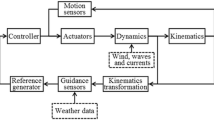Abstract
According to the requirements of real-time performance and reliability in underwater maneuvering target tracking as well as clarifying motion features of the underwater target, an interacting multiple model algorithm based on fuzzy logic inference (FIMM) is proposed. Maneuvering patterns of the target are represented by model sets, including the constant velocity model (CA), the Singer model, and the nearly constant speed horizontal-turn model (HT) in FIMM technology. The simulation results show that compared to conventional IMM, the reliability and real-time performance of underwater target tracking can be improved by FIMM algorithm.
Similar content being viewed by others
References
Roberts G, Sutton R (2006) Advances in unmanned marine vehicles [M]. United Kingdom: Michael Faraday House
Zhou Hongren, Jing Zhongliang, Wang Peide (1991) Tracking of maneuvering targets [M]. Beijing: Publishing House of National Defense Industry (in Chinese)
Gustafsson F, Gunnarsson F, Bergman N, et al. (2002) Particle filters for positioning, navigation and tracking [J]. IEEE Transactions on Signal Processing, 50(2): 425–437
Yaakov B S, Li Xiaorong (1993) Estimation and tracking: principles, techniques and software [M]. London: Artech House
Samuel B, Robert P (1999) Design and analysis of modern tracking system [M]. London: Artech House
Yang Wanhai (2004) Multi-sensor data fusion and application[M]. Xi’an: Xidian University Press (in Chinese)
Hu Baoqing (2004) Fundamentals of fuzzy theory [M]. Wuhan: Wuhan University Press
Ding Zhen, Henry L, Keith C, et al. (2001) Model-set adaptation using a fuzzy Kalman filter [J]. Mathematical and Computer Modeling, 34: 799–812
Shen Bin, Dong Chaoyang, Chen Yu, et al. (2005) Fuzzy adaptive interacting multiple model algorithm [J]. Journal of System Simulation, 17(10): 2 345–2 348 (in Chinese)
Chan K C, Lee V, Leung H (1997) Generating fuzzy rules for target tracking using a steady-state genetic algorithm[J]. IEEE Transactions on Evolutionary Computation, 1(3): 189–200
Tian Tan, Liu Guozhi, Sun Dajun (2000) Sonar technique [M]. Harbin: Publishing House of Harbin Engineering University (in Chinese)
Author information
Authors and Affiliations
Corresponding author
Additional information
Supported by the National Natural Science Foundation of China (No.40067116), the Research Development Foundation of Dalian Naval Academy (No.K200821).
About this article
Cite this article
Xu, W., Liu, Y. & Yin, X. Method for underwater target tracking based on an interacting multiple model. Geo-spat. Inf. Sci. 11, 186–190 (2008). https://doi.org/10.1007/s11806-008-0092-x
Received:
Published:
Issue Date:
DOI: https://doi.org/10.1007/s11806-008-0092-x




